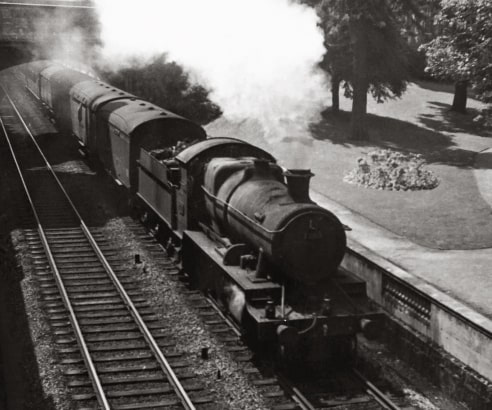The Trans-Siberian Railway or the Great Siberian Route is the main railroad artery of the country that connects the European part of Russia with Siberia and the Far East regions.
The actual length of the main passenger route from Moscow to Vladivostok is 9288.2 km (5771.4 miles) which makes the legendary railroad the longest one on our planet. It is known that the Trans-Siberian Railroad connects two parts of the world, passing the territory of 20 subjects and five federal districts of the Russian Federation. The European part of the Trans-Siberian covers about 19% of the total length of the railway against 81%, belonging to Asia, with the conditional border on the 1778th kilometer.
The Trans-Siberian railroad history started more than a century ago. And it is no surprise that the issue of building such a long-distance railroad across Russian vast expanses was quite poignant. Just imagine that at the end of the 19th century the vast areas of Siberia and the Far East still remained isolated from the European part of the Russian Empire, meaning that organizing a path, allowing to get from one part of the country to another within minimal time and expenses was quite a big deal and thus became a priority of governmental scale.

In February 1891, the Committee of Ministers recognized the possibility of starting construction works of the Trans-Siberian Railway simultaneously from two sides - from Chelyabinsk and Vladivostok, towards the center.
Interested in when was the Trans-Siberian railway built? The official start date of the Transsib construction was May 31, 1891, when the heir to the Russian throne and future emperor Nicholas II laid the first stone of the Ussuri Railway near Vladivostok. Since then the grand construction swept the whole country.
If you have already traveled or plan to set off on an unforgettable Trans-Siberian journey, or at least have an understanding of what Siberia and wild Russian taiga is like, you can assume the severe conditions the Trans-Siberian railway construction was held in.
Hilly landscapes, frozen ground, swamps, cold weather, turbulent rivers, primitive equipment, and materials are just some of the difficulties the railway constructors faced. Considering the scale of the construction, the biggest rail project of the country demanded great resources, both human and financial. According to the preliminary calculations by the Committee for the Construction of the Trans-Siberian Railway, its value was determined at 350 million rubles in gold. However, the most problematic issue was providing the construction with great human resources.
The need for skilled workers was satisfied by recruiting constructors and builders to Siberia from central regions of the country. A large part of the builders were soldiers and exiled prisoners, transferred to the Far East as a punishment. The replenishment of the workforce also came at the expense of attracting Siberian peasants and locals.
To put the scale in figures, about 9.6 thousand people were employed in the construction of the Trans-Siberian railroad at the first steps, while in the midst of construction the number of people who built the Trans-Siberian railroad grew to 84-89 thousand people. Quite impressive, don’t you think? Unfortunately, the human losses were just as impressive as well and were estimated in thousands of lives.
Facts about Trans-Siberian Railway
Talking about some interesting Trans-Siberian railway facts, the first trains began to transfer passengers from Moscow to Vladivostok in 1903, even before the entire construction of the Trans-Siberian Railway was completed. Although there was a gap in the railroad - in the region by Lake Baikal - people overcame this area by transporting trains through the lake on a special ferry.
Nevertheless, the newly built Trans-Siberian railroad celebrated its official birthday only in the year of 1916, then the construction was completed on the territory of the whole Russian Empire from start to finish.

During the time of the Second World War, the railroad served as the main transportation for the evacuation of the civilian population from the occupied territories, as well as the uninterrupted delivery of cargo and military forces to the war zone, still continuing the inter-Siberian traffic. Afterward, in the post-war years, the Great Siberian Railway was actively rebuilt and modernized.
All in all, it’s needless to say, that the Trans-Siberian railroad has become the backbone of the Russian rail network and a new vector of development and prosperity, significantly accelerating passenger traffic and turnover of goods. The regions served by the Trans-Siberian railroad possess more than 80% of the country's industrial potential and basic natural resources including oil, gas, coal, timber, nonferrous metals, and so on.
Nowadays, it is a modern double-track electrified railway line, providing access to the network of railways of China and Mongolia.
Besides, touring the Trans-Siberian is a real adventure and a great chance to see literally all sides of diverse and immense Russia.
Trans-Siberian travel usually starts in beautiful Moscow, passes through the most interesting cities of the European part of Russia, including Kazan and Ekaterinburg, followed by stunning scenery and gorgeous Siberia panoramas of Lake Baikal and the Ural Mountains, then crosses the mighty 2 km-long Amur Bridge and the 7 km-long tunnel under the Amur River, proceeding with untouched Siberian taiga with the final stop in the Eastern Capital of Russia, Vladivostok!
What is more, the Trans-Siberian railway provides easy connections with the Trans-Mongolian (Moscow to Ulan Bator) and Trans-Manchurian (Moscow to Beijing) railways in case you desire to enrich your Trans-Siberian experience.

